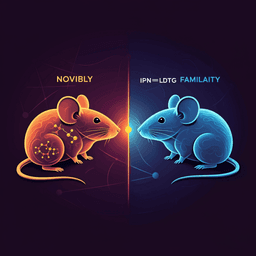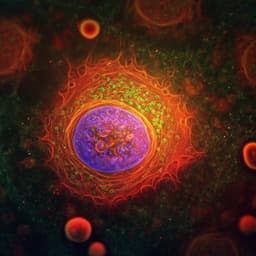
Psychology
Dopamine control of social novelty preference is constrained by an interpeduncular-tegmentum circuit
S. Molas, T. G. Freels, et al.
Explore the fascinating world of social interactions as this innovative research by Susanna Molas and colleagues reveals how mesolimbic dopamine influences mice's preference for novel social stimuli. Discover how specific neural circuits dynamically regulate these responses and challenge your understanding of social behavior!
~3 min • Beginner • English
Introduction
Social behaviors are dynamic, innate motivational behaviors frequently disrupted in neurodevelopmental and neuropsychiatric disorders. Across species, animals preferentially investigate novel over familiar conspecifics, a strategy important for evaluating threats and new social or mating opportunities. With repeated exposures, responses to social novelty habituate, reflecting fundamental behavioral plasticity. Mesolimbic dopamine (DA) transmission from ventral tegmental area (VTA) to ventral striatum is engaged by social cues in humans and animals and is often interpreted in terms of reward prediction error and learning. However, how DA activity patterns evolve as a social cue transitions from novel to familiar, what components of social interaction DA encodes (e.g., approach, bout length), and the real-time DA dynamics during social novelty preference (NP) remained unclear. Prior work identified the interpeduncular nucleus (IPN) as a substrate for familiarity signaling involved in NP. Emerging evidence suggests the IPN orchestrates avoidance-related behaviors, but the dynamics and output pathways relevant to NP were not known. This study investigates how mesolimbic DA encodes social novelty and how an IPN→laterodorsal tegmentum (LDTg) pathway constrains NP by influencing DA signaling.
Literature Review
Methodology
- Subjects: Male and female mice (C57BL/6J; transgenic lines: DATCre, GAD2Cre, ChATCre) bred in-house. Juvenile social stimuli were sex-matched C57BL/6J (4–7 weeks). Standard housing; reversed light cycle before testing. All procedures approved by IACUC.
- Behavioral paradigms: Three-chamber sociability/novelty assay. Days 1–3: repeated exposure to the same juvenile conspecific (novelty to familiarity). Day 4: NP test with simultaneous novel and familiar conspecifics. Exploration defined as nose within <2 cm of cylinder; bouts and bout lengths annotated frame-by-frame by blinded experimenters. NP ratio = (novel time − familiar time)/(total social investigation time).
- Fiber photometry: Doric system with dual-excitation (465 nm signal; 405 nm isosbestic). Biosensors: GCaMP6m/7s for calcium; dLight1.2 for DA. Signals demodulated, low-pass filtered (3 Hz), 405 nm regressed onto 465 nm; ΔF/F computed and converted to z-scores using −3 to 0 s baseline. Peak onset/latency and AUC computed; alignment to onset and (for IPN) offset of investigations. Events with intertrial interval <2.5 s excluded. Custom Matlab/Python scripts used.
- Stereotaxic surgeries and viral tools: AAVs expressing Cre-dependent GCaMP (AAV5/rg), dLight1.2 (AAV5), reporters (mCherry/eGFP), opsins (ChrimsonR, ChR2, eNpHR3.0) injected into targeted structures. Coordinates (mm from bregma): IPN (−3.4, ML ±0.5, DV −4.86, 6°), VTA (−3.4, ±0.35, −4.25), NAc (+1.4, −0.9, −4.2), LDTg (−5.1, ±0.4, −3.1), DR (−4.36, +0.5, −3.04). Fibers (200 µm, NA 0.53) implanted above targets. Verification of placements by fluorescence microscopy; animals with missing/mistargeted expression excluded.
- Optogenetics: Closed-loop photostimulation during NP when mice entered cylinder zones. Parameters: VTA DA cell bodies (ChrimsonR, 593–595 nm, 30 Hz, 8 ms, 5 s ON/5 s OFF); IPN→LDTg axons (ChrimsonR, 593–595 nm, 20 Hz, 12 ms/pulse); IPN→LDTg inhibition (NpHR3.0, 593 nm constant). Light intensity ~5 mW at fiber tip. Controls: mCherry/eGFP.
- Circuit tracing: Anterograde (AAV-DIO-eGFP/mCherry in IPN GAD2Cre) to identify projections; presynaptic marker colocalization (synaptophysin, VIAAT). Retrograde AAVrg-FLEX-eGFP from LDTg to label IPN→LDTg GAD2 neurons. Transsynaptic AAV1-Cre (VTA) with Cre-reporter in IPN to identify LDTg ChAT+ neurons connected to IPN and projecting to VTA.
- Electrophysiology: Acute slices from ChATCre mice with AAVrg-DIO-mCherry in VTA (labels LDTg→VTA ChAT+ neurons) and AAV5-ChR2-eYFP in IPN. Whole-cell voltage clamp of LDTg mCherry+ neurons; blue-light (470 nm, 1 ms) stimulation of IPN terminals. AMPA/NMDA blocked (NBQX/D-AP5). GABAA blockade with picrotoxin (50 µM) to test IPSC sensitivity; I–V and reversal potential assessed; onset latency measured.
- Immunohistochemistry: Standard PFA perfusion, sectioning, antibody labeling (ChAT, VIAAT, synaptophysin, TH, Tph2) and DAPI counterstain; fluorescence microscopy.
- Statistics: Two-tailed unpaired t tests, one-/two-way (repeated-measures) ANOVA with Šidák post hoc; Pearson correlations. Data reported as mean ± SEM; alpha p<0.05. Analyses in GraphPad Prism; multiple independent cohorts for behavior; representative images from ≥3 animals.
Key Findings
- VTA DA neuron activity and NAc DA release preferentially encode initial social novelty and bout length:
- VTA DA GCaMP signals increased strongly to the first novel social investigation and habituated within-session and across days; females showed lower magnitude than males (sex main effect F(1,7)=8.964, p=0.020).
- Day 1 first-bout VTA activity correlated with interaction bout length (Pearson r=0.7104, R2=0.5046, p=0.0483); no significant correlation on Days 2–3.
- NAc dLight1.2 signals mirrored VTA dynamics: larger to first novel interaction on Day 1 with rapid habituation; correlation with first-bout length on Day 1 (r=0.7210, R2=0.520, p=0.0436), not Days 2–3.
- Across bouts and days, two-way RM ANOVAs confirmed higher responses for first vs subsequent interactions and decline with familiarity (e.g., VTA: time F(2,14)=9.60, p=0.0049; bout F(1,7)=8.84, p=0.0207; interaction F(2,14)=8.57, p=0.0073. NAc: time F(2,14)=8.348, p=0.012; bout F(1,7)=12.84, p=0.0089; interaction F(2,14)=10.94, p=0.0047).
- Behavior during NP arises from longer bout lengths to novel, not more frequent approaches:
- In NP, mice investigated novel longer than familiar (t(62)=2.820, p=0.0064), with similar bout numbers (t(62)=0.8322, p=0.4085) but longer bout lengths to novel (t(62)=4.133, p=0.0001).
- VTA DA activity during NP was higher for novel vs familiar and for first vs subsequent bouts (ANOVA novel/familiar F(1,14)=12.96, p=0.0029; bout F(1,14)=9.279, p=0.0087; interaction F(1,14)=9.011, p=0.0095).
- Causal role of DA: VTA DA photostimulation boosts novelty seeking by prolonging bouts and increasing NAc DA:
- Closed-loop Chrimson activation of VTA DA neurons increased investigation time for novel (t(26)=2.950, p=0.0066) but not familiar (p=0.987) stimuli by prolonging novel bout length (virus main effect F(1,26)=8.589, p=0.0070), without increasing bout number.
- Simultaneous dLight recordings showed enhanced NAc DA during novel bouts with VTA stimulation (virus main effect for novel F(1,18)=5.154, p=0.0357).
- IPN GAD2 neurons encode familiarity and termination of social investigation:
- IPN GAD2 activity was inhibited during novel investigations and higher for familiar vs novel (ANOVA main effect F(1,14)=4.926, p=0.0435); inhibition during novel bouts was prolonged.
- At bout offset, IPN GAD2 activity increased more for familiar than novel terminations (t(14)=2.415, p=0.03).
- Prior photoinhibition of IPN GAD2 cell bodies increased familiar bout length (reanalysis of ref. 15).
- IPN→LDTg GAD2 projection mirrors IPN dynamics and is necessary for terminating familiar bouts:
- Tracing identified IPN GAD2 projections to LDTg; terminals colocalized with synaptophysin and VIAAT.
- Retro-labeled IPN→LDTg GAD2 neurons reside in ventral-caudal IPN.
- Photometry of IPN→LDTg cell bodies showed inhibition during novel exploration and increased activity at familiar bout offset (offset t(8)=2.992, p=0.0173).
- Closed-loop optogenetic inhibition of IPN→LDTg (NpHR3.0) increased familiar investigation time (t(14)=3.055, p=0.0086) and prolonged familiar bout length (virus main effect F(1,14)=5.159, p=0.0394) without changing bout number; NP ratio reduced.
- Control inhibition of IPN→DR had no effect.
- IPN inhibits LDTg ChAT+ neurons projecting to VTA:
- AAV1-Cre transsynaptic strategy and ChAT immunostaining indicated that IPN-connected LDTg neurons projecting to VTA are cholinergic.
- In slices, optogenetic activation of IPN terminals evoked IPSCs in LDTg→VTA ChAT+ neurons with Cl− reversal potential and onset ~5 ms; IPSCs reduced ~46% by picrotoxin, confirming GABAergic monosynaptic inhibition.
- Activating IPN→LDTg constrains novelty exploration by reducing bout length and NAc DA:
- Closed-loop Chrimson activation of IPN→LDTg axons reduced novel investigation time (t(19)=2.537, p=0.0201) and NP ratio (t(19)=3.633, p=0.0018) by shortening novel bout length (virus main effect F(1,19)=5.118, p=0.0356), without affecting bout number or total exploration.
- Concurrent dLight recordings showed reduced NAc DA during novel investigations with IPN→LDTg activation (significant interaction for novel F(1,12)=6.798, p=0.0229).
Discussion
The study addresses how social novelty preference is computed and constrained by brain circuits. Mesolimbic DA signaling, measured at VTA cell bodies and NAc terminals, is strongly biased toward the first encounter with a novel conspecific and scales with bout length, consistent with DA encoding salient, rewarding aspects of social novelty that motivate sustained interaction. This novelty-driven DA response rapidly habituates, aligning with decreased salience upon familiarization. During NP, behavioral preference arises from extended bout duration with the novel stimulus, and optogenetic enhancement of DA transmission selectively prolongs novel bouts and elevates NAc DA, demonstrating a causal role for DA in sustaining novelty-driven interactions.
In contrast, IPN GAD2 neurons and specifically the IPN→LDTg projection exhibit inverse dynamics: they are inhibited during novel exploration and activated at the termination of familiar social bouts. Causally, inhibiting IPN→LDTg prevents termination of familiar interactions (prolonging familiar bout length and reducing NP), whereas activating this pathway shortens novel bout length and diminishes NAc DA release. Electrophysiology reveals that IPN provides GABAergic monosynaptic inhibition onto LDTg ChAT+ neurons that project to VTA, offering a mechanistic route by which IPN can reduce cholinergic drive to VTA and thereby dampen mesolimbic DA output.
Together, these findings support a model in which mesolimbic DA encodes and sustains interest in novel social stimuli, while an inhibitory IPN→LDTg circuit dynamically regulates and constrains social exploratory behavior—particularly terminating interactions when stimuli are familiar—by modulating DA transmission. This circuit interplay refines social action sequences and may be relevant to disorders with social motivation deficits.
Conclusion
This work delineates complementary roles of mesolimbic DA and an IPN→LDTg inhibitory pathway in social novelty preference. DA activity and NAc DA release encode the initial novelty response and bout length, driving longer interactions with novel conspecifics. The IPN GAD2→LDTg circuit counterbalances this by activating at the termination of familiar interactions and, when engaged, suppressing DA release to shorten novelty bouts, thereby constraining NP. The study provides mechanistic, causal evidence that IPN can rapidly regulate mesolimbic DA via LDTg cholinergic neurons.
Future directions include: determining how novelty-driven DA signals support associative learning versus immediate motivational drive; dissecting whether IPN also targets LDTg GABA/glutamatergic populations relevant to DA modulation; exploring context dependence of novelty salience and DA responses; and assessing the IPN→LDTg pathway in models of neurodevelopmental and psychiatric disorders (e.g., autism) with social motivation impairments.
Limitations
- The study focuses on mouse models and circuit-level mechanisms; translational relevance to humans is inferred but not directly tested.
- Novelty responses show context dependence; DA engagement during NP did not fully recapitulate Day 1 magnitudes, suggesting environmental/state variables that were not systematically varied.
- While evidence supports IPN inhibition of LDTg ChAT+ neurons, potential contributions of LDTg GABAergic and glutamatergic populations were not excluded and warrant future dissection.
- Fiber photometry provides population-level signals without single-cell resolution; distinct neuronal subtypes within regions may have heterogeneous dynamics.
- Sample sizes in some photometry/optogenetic cohorts are modest; replication across additional cohorts and conditions would strengthen generalizability.
Related Publications
Explore these studies to deepen your understanding of the subject.







